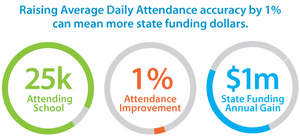NEW YORK, NY--(Marketwired - Feb 23, 2016) - ScholarChip®, the premier one-card identity and attendance platform for K12 schools, demonstrates that by automating attendance, school districts can dramatically improve state financial aid by increasing their Average Daily Attendance (ADA) accuracy. Making only a one percent modification can impact funding for education, sometimes by a million dollars a year, depending on the state and school district.
"When you do the math, the results can be considerable," said Maged Atiya, PhD, ScholarChip CEO/CTO. "And when states rely heavily on ADA for a large part of their operating budget, like those in the south and west, a Smart Card ID System can easily pay for itself within the first year."
ADA is calculated by taking the aggregate number of days of attendance of all students during a school year, divided by the number of days school is in session during that year. This clerical task falls on teachers, and if they don't know if a student is expected to be late, is in the nurse's office, is at an off-campus event, or has another scheduled issue, that student could be mistakenly marked absent. These types of miscounts happen all the time.
In Texas, for example, an average school district contains approximately 28,000 students, with 1,600 teachers in 35 schools. It's possible to assume that when those teachers count so many students by hand, there is a reasonable chance for mistakes to be made. Multiply that by 180 teaching days and the potential for inaccuracy is exceedingly high.
On March 18, 2015, The Dallas Morning News reported that, "Texas schools are spending an average $9,559 per student in the current school year." The National Education Association of Texas says these funds are received from a number of sources, including local property taxes, and the State and Federal government. The State of Texas provides 40 percent of that expenditure.
$9,559 x 40% = $3,824 per student received from the State of Texas
Consider that in a normal year the absentee rate could range between 5 and 18 percent. On average, that means approximately 11.5 percent of students are out of school.
28,000 x 11.5% = 3,220 students
28,000 - 3,220 = 24,780
For 24,780 students that are in school, it can be said that teachers consistently mark one percent of students absent by mistake:
24,780 x 1% = 247.8
247.8 x $3,824 per student = $947,587 lost annually
Therefore, if an average school district increases ADA accuracy by only one percent, it can signify almost one million dollars in extra revenue for that year that could be spent on computers, software, art supplies, musical instruments, day trips, salaries, new classrooms, overhead, or any other expense that a district or school might have. A small increase in ADA accuracy means a huge increase in funds.
ScholarChip uses passive ISO-standard contactless ID cards that have no battery. They draw power from the reader; students must take action to check in, like tapping it on a screen, therefore they do not infringe on privacy. This process makes it very easy to track where students are, and districts can get an accurate count of how many people have checked in at any particular time. Also, these cards are more durable, hence they have a lower overall cost. Their form factor is identical to standard cards, making adoption easier, too. Students too young to use cards can use a small plastic fob attached to their book bag.
Automating the attendance process with ScholarChip's Smart ID Card technology also means increased school safety through services like secure door access; quicker student attendance issue intervention; and improved cafeteria and school lunch program accountability, to name only a few additional benefits.
About ScholarChip
ScholarChip has pioneered the concept of a centralized and integrated School Safety and Operations System-a true academic one card solution. To meet the growing need for mobile technology in schools, ScholarChip has developed Apps and smart ID cards that operate seamlessly with NFC mobile devices. In addition, ScholarChip's Higher Education services extend to high performance Tuition Payment Plans, Loan Servicing and a compliant Payment Gateway. For more information visit http://www.scholarchip.com.
ScholarChip is a registered trademark of ScholarChip. Other product and company names may be trademarks of their respective owners.
Contact Information:
Contact:
Nancy Napurski
Lionheart Communications
585-967-3348
